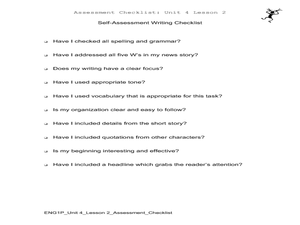Curated OER
Inverted Triangle
In this graphic organizer worksheet, students will write a broad topic on the top line of the inverted triangle. Then students will write part of that topic on the next smaller line. Students will continue until they get a focused topic.
Curated OER
Webbing
In this graphic organizer worksheet, students complete an idea web and write the information in the provided bubbles. The web is similar to a bubble map and has five spaces for students to write information.
Curated OER
Make a Key to Identify Animals
In this developing a graphic organizer about animals worksheet, students make a key to identify animals that live in water, does or doesn't have legs, eats meat, flies, grows from a tadpole, and has a shell. Students write 12 short answers.
Curated OER
Problem-Solution Chart
In this using a graphic organizer to problem solve worksheet, students fill in the blanks on the chart to tell who, what and why the problem, solutions tried and their results, and the end results. Students write 8 answers.
Have Fun Teaching
The State of Things
Is it a solid, liquid. or gas? Cut out these graphics for a fun manipulative game that has kids sorting everyday items into their states of matter. They complete three worksheets referencing the sorting activity.
Lampstand Press
Compare/Contrast Worksheet
Walk your class through the process of writing compare and contrast essays with this easy-to-use graphic organizer. After first using the included Venn diagram to record the similarities and differences between two subjects,...
Notebooking Fairy
Timeline
Four different timeline graphic organizers are included here. The first has six boxes, the second eight, and the third and fourth ten in slightly different formats. Each page includes space to write in a title or other information, such...
Ed Helper Clip Art
Character Problem Solution
Intended for younger audiences, children identify the main characters, setting, problem, events, and solution in a graphic organizer.
Ed Helper Clip Art
Main Idea Mountain
After reading a text, learners fill out a graphic organizer in the shape of a mountain, with the main idea as the peak.
Curated OER
Writing a Music Review
In this graphic organizer worksheet, students read a music review, watch a traditional music performance or listen to a sound recording from the "Louisiana Folklife Program" website, and review notes about careers in music. Students...
Curated OER
Essay Outline
In this essay outline worksheet, students complete a graphic organizer that is divided into 5 sections. These include, "topic sentence, first, next, then, and last."
Curated OER
Who Am I?
Your budding journalists need to understand the five W's for writing a news story. They read a story, complete several graphic organizers to help them organize and write their article, and then use a self-assessment learning exercise to...
Friends of Fort McHenry
Sensory “Star Spangled Banner”
Music can help us to access memories and events in a meaningful way, and Francis Scott Key used specific words to convey what he had seen and felt when writing what would become America's national anthem. Help your class connect to...
Curated OER
Writing a Story: Planning
In this rewriting a familiar story worksheet, students choose a familiar story and fill in the squares of a graphic organizer with new information about the characters, setting, story starter, ending. and/or main events. Students write 5...
Polk Bros Foundation
Meet the Nonfiction Main Idea Challenge
Help your class develop the ability to determine a main idea with a packet of materials that you can introduce and use over a period of time. The packet includes some information for the teacher and rationale for the exercises. There are...
Curated OER
Predictions: Technologies of the Future
Visit the world of science fiction with this graphic organizer focusing on predictions. Complete the chart to determine the possible positive and negative side effects for two examples of future technology. Then, have writers choose one...
Lawrence Virtual School
Context Clues
Considering a lesson on using context clues to figure out the meaning of unfamiliar words? This packet includes a brief reading passage about strategies readers can use and 12 very different graphic organizers, including a template for a...
Curated OER
Study Guide for Missing May
Use this comprehensive packet to accompany a study of Missing May by Cynthia Rylant. Starting out with a brief author biography and background information about the novel, this guide includes materials to use throughout the entire novel....
California Education Partners
From Seed to Pumpkin by Wendy Pfeffer
Conduct a lesson that leads into a writing assessment. After reading an excerpt from From Seed to Pumpkin, first graders demonstrate their interpretation of sections of the passage by sketching the details from each part.
Polk Bros Foundation
How to Summarize a Non-Fiction Passage
After reading a text, one way to find out how much your class comprehended is to ask your pupils to summarize. This worksheet helps class members prepare for writing a summary of a nonfiction text. They note down the topic, up to eight...
Lerner Publishing
Meet the Dinosaurs
Take your class of youngsters on a prehistoric adventure with this four-lesson series on dinosaurs. Accompanying the Meet the Dinosaurs books by Don Lessem, these lessons engage children in writing their own dinosaur books,...
Teacher's Corner
Dr. Seuss Author Study
Want to know more about Dr. Seuss? Scholars research topics such as his childhood, family, education, jobs, and story themes to learn more about the ever-popular and fun to read author, Dr. Seuss.
Curated OER
Character Analysis Chart
This versatile graphic organizer could be used alongside any novel, poem, play, or story through which your class in studying character. Class members can get characters straight or describe particular characters in more detail with this...
Curated OER
My School Rules! Your School Drools!
In this writing worksheet, students fill out a brainstorming graphic organizer about why they like their school. They are then prompted and guided through writing a first and final draft of a paragraph using their ideas.























